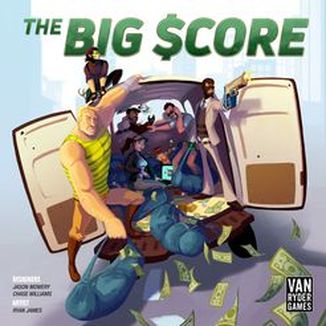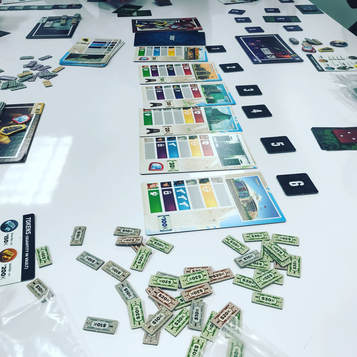 Full Disclosure: Van Ryder Games provided me with a review copy of The Big Score. What is this game about? The Big Score is a game about being a criminal mastermind and making off with the biggest possible pile of loot. It is separated into two acts. In Act I, you complete smaller jobs to build up some capital and get yourself set up for a bigger heist. You'll hire and assign crew members and try to collect as much cash as possible so that you have a healthy money base before taking some bigger financial risks. In the multiplayer version of the game, there are six jobs laid out on the table. Players secretly assign crew to jobs that interest them, and then, after all the cards are down, they reveal their choices to see whether the table as a whole contributed enough hired hands to manage their mischief. If a job is successful, all players reap the rewards. If it isn't, players who contributed to that job emerge from it empty-handed. In Act II, "The Big Score," players enter into the ultimate push-your-luck challenge. Each round, everyone will reach into a (very cool looking) bank vault and draw out a token. Some of the tokens are worth pretty lame amounts of money, but others are worth a lot. Still other tokens, however, are cops—and if the cop track hits its maximum, every player who is still trying to rob the vault gets busted and loses all money accumulated during Act II. As you play, you can choose to keep grabbing tokens from the vault, or you can choose to flee. This can get pretty dramatic, because during each turn in Act II, players all draw tokens and reveal them at the same time. So each turn, you'll be looking around to see what everyone else got, and whether someone turns up an empty palm—a signal that he or she has fled. How does it play solo? The Big Score does have a solo mode, one that plays very differently from the multiplayer version of the game. There are several solo scenarios that offer different challenges, as well as a solo-specific rulebook to help clarify how the solo game differs from the multiplayer one. There are still two acts to the game. In Act I, players create three equally-sized decks of crew cards, then work through one deck per round. You need to assign specific types of crew cards to complete different jobs, but there are limits on which cards you can draw and deploy on each turn. Unlike in the multiplayer game, you can spend some of your money to draw extra cards, keep cards in your hand, shuffle cards you think you'll need into the next round's deck, and more. In fact, it's easy to keep blowing money trying to get jobs done, so much so that, if you aren't careful, you can end up spending more on a job than you earn back from it. A lot of the solo version of The Big Score is about counting cards, paying attention, and recognizing diminishing returns. In Act II, you'll still be drawing from the vault until you either flee or bust. But you will draw multiple tokens per turn, and while you have to put the first cop you draw each turn on the cop track, you can bribe any extra ones to look the other way. This definitely adds an interesting element to the game that doesn't exist in multiplayer—and can definitely make you spend more money than you wanted to!  When students ask to play a game again... it's a winner. When students ask to play a game again... it's a winner. Overall Thoughts I am honestly surprised that the solo mode for The Big Score turned out as well as it did. At its heart, this is very much a social game about bluffing and pushing your luck. I will say up front that The Big Score is definitely better with friends. My game club students really enjoyed it, and after their first game, they immediately asked to play it again. It's a ton of fun, and I can't wait to teach it to more people. The solo game does have some interesting elements that I enjoyed. I liked the tension of deciding whether to spend money to keep hunting through the crew deck while trying to complete one last job. Keeping track of what crew members I had already seen and assessing the value of continuing to press my luck gave the game some tension, even without other players at the table. I also enjoyed being able to bribe cops in Act II, something that is not an option in multiplayer. That said, these same elements came with some in-game difficulties of their own. If you have a bad shuffle and just cannot draw the right crew members at the right time, you will not have a very enjoyable Act I. This becomes even more true if you have a specific in-game earning goal, as you do in the solo scenarios—especially if you have also just spent a lot of money hoping for a return on your investment. In the multiplayer game, not drawing the right crew is more bearable, because you aren't trying to reach a specific amount of money. You only have to earn more money than everyone else. Also, in multiplayer, everyone has the option of using a "jack of all trades" token once per turn to help complete a job that is missing crew members. Choosing when to flee during Act II is also far less interesting in the solo game. Because you are trying to reach a specific profit goal, it's simply a matter of keeping track of your money in your head. Do you have the amount you need? Go ahead and flee! Are you still short? Might as well press on—if you get busted, it doesn't really matter, because you were going to lose anyway. Do I recommend it? I would not recommend buying The Big Score specifically to play it solo. But the solo mode is engaging. If you enjoy pushing your luck, keeping track of where your funds are at, and counting cards, then you'll have a good time. If you dislike "lucky" solo games, walk on by. Overall Rating: 3 stars 5 stars — I love it! 4 stars — I really like it. 3 stars — I like it. 2 stars — It's okay. 1 star — Meh.
0 Comments
Your comment will be posted after it is approved.
Leave a Reply. |
AuthorMy name is Liz Davidson, and I play solo board games. A lot of solo board games... Archives
August 2021
Categories
All
|
 RSS Feed
RSS Feed